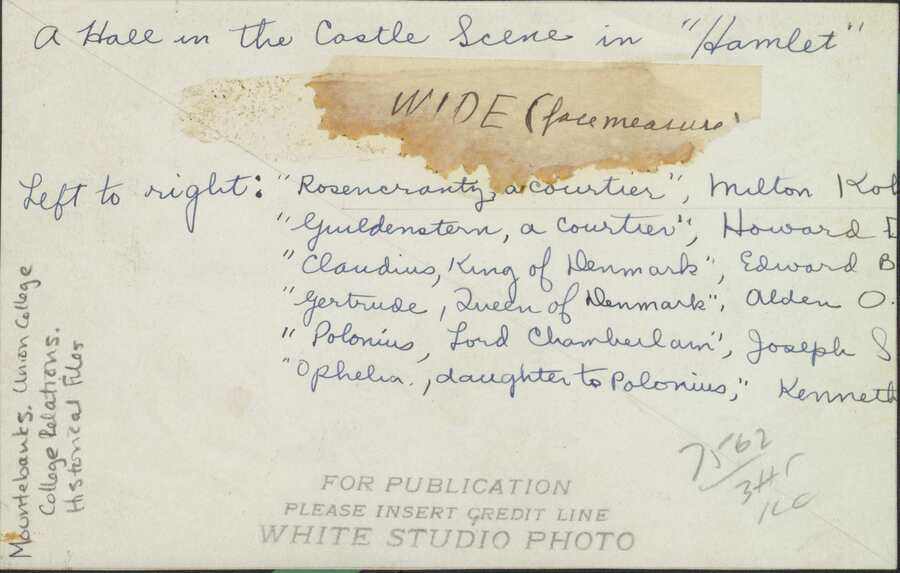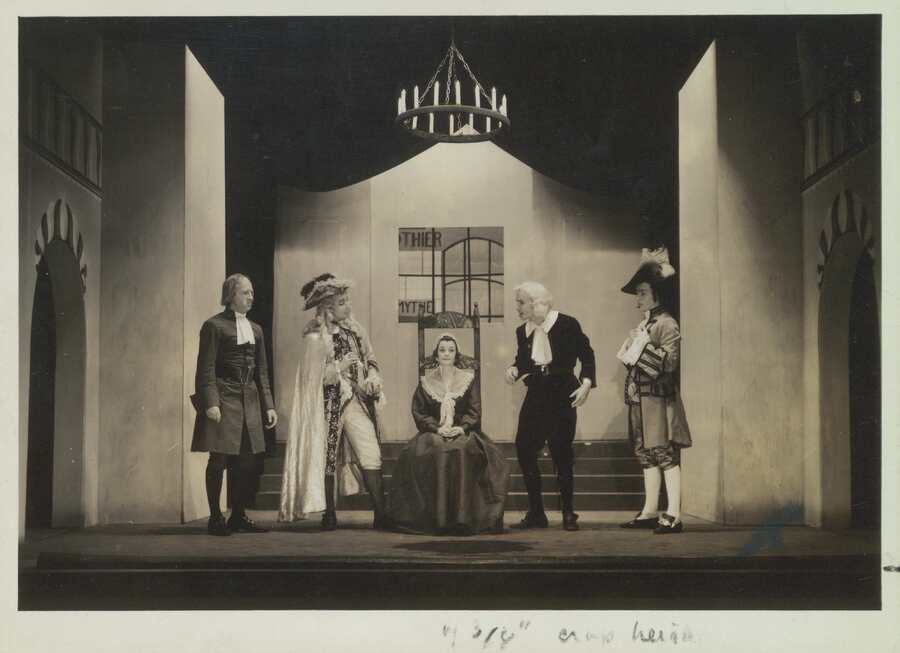"His Gowns Were Wonderfully Becoming"
Union College Mountebanks, 1912-1934
Union College Mountebanks, formed in 1912, is considered the oldest student-run theater group in the United States. During the group's first two decades, in all of their shows, which ranged from their inaugural performance of Susanna Centlivre's satirical play A Bold Stroke for a Wife, to their showing of Roi Cooper Megrue and Walter Hackett's comedy It Pays to Advertise in 1920, to their staging of Shakespeare's Hamlet and Gilbert and Sullivan's comic opera Trial By Jury, both in 1933, female characters were performed by male Union students in drag.
Front of a photograph of the Mountebanks Cast performing Hamlet in March 1933. featuring six cast members. The two female characters pictured, Gertrude and Ophelia, are portrayed by male students in drag.
Handwritten details on the back of the photograph. The title describes the scene captured in the photograph ("A Hall in the Castle Scene,") and it lists the cast members who are pictured from left to right. The characters of Gertrude and Ophelia are played by "Alden" and "Kenneth," respectively.
Front of a photograph of the Mountebanks Cast performing Trial By Jury in May 1933. Twenty characters are gathered on stage in a courtroom scene. The female characters present - four bridesmaids and a bride - are portrayed by male students in drag.
Were Mountebanks' practices out of the ordinary? How commonplace was cross-dressing in order to fulfill theater roles?
There is actually an expansive history of cross-dressing occurring in theater, dating back at least to the time of the ancient Greeks [1]. Women were banned from performing in theater throughout the western world until the seventeenth century, and therefore male actors played female characters regularly [1]. Even once women performing in theater was no longer illegal, the practice of male actors cross-dressing to play female characters did not immediately fade away, as the performance world remained male-dominated. While the use of drag was in fact deployed as a misogynistic means of mocking women and as a ploy to make audiences laugh in minstrel shows, there were many theatrical contexts in which cross-dressing was not viewed as a mockery and was taken seriously as a performance.
Some of the most popular plays of the 19th and 20th centuries have featured men impersonating women, usually out of necessity rather than choice [1].
A review of Mountebanks' showing of It Pays to Advertise, which was published on May 25, 1920 in the Concordiensis, indicates that no fanfare was made out of the all-male cast of performers, and that the performances were not designed to come across as sexist mockeries. The article gives glowing praise to the performances of two students in leading female roles, even complimenting the gown worn by the principal character, writing:
his gowns were wonderfully becoming [2].
Students at Union College taking up this practice as members of an all-male institution in the early twentieth century, therefore, fits into a broader historical trend. The practice came to an official end via a change in Mountebanks policy in 1934. This policy required the female roles in their shows to be portrayed by women community members, most commonly the wives of faculty or students [3]. No specific, discernable reason as to why this policy change was enacted is given.
The use of drag performance in theater at Union College from 1912 to 1934, and its commonality in other theatrical spaces as well, serves to challenge normative cultural views about strict and rigid gender presentation.
[1] Gewertz, Ken, July 17, 2003, "When Men were Men (and Women, too)," published in The Harvard Gazette.
[2] May 25, 1920, "Mountebanks Delight Appreciative Crowd," published in the Concordiensis.
[3] June 8, 1935, "Eight Years Under Carroll," published in the Concordiensis.






